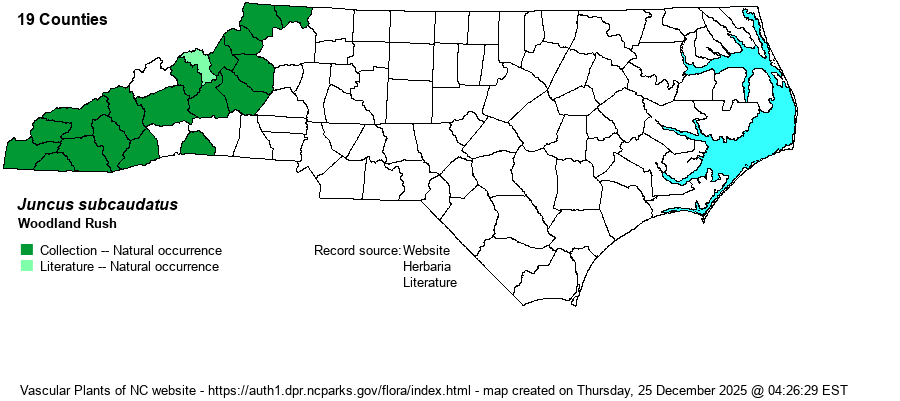| Author | (Engelmann) Coville & S.F. Blake | |
| Distribution | Mountains only.
Mostly Appalachian, Newf. to GA and AL; scattered west to the Ozarks of MO and AR. | |
| Abundance | Frequent -- fairly common to common; records for all but 3 Mountain counties. | |
| Habitat | Streambanks, wet to moist woodlands and open forests, montane seepage bogs. Prefers shaded wetlands. | |
| Phenology | Flowering and fruiting July-October. | |
| Identification | Woodland Rush belongs to the J. canadensis group, with hemispherical to rounded heads. Unlike Canada Rush, the seeds have short tails (vs. long). The inflorescence is open and wide-spreading, versus narrow and rather compact in J. brevicaudatus. | |
| Taxonomic Comments | Some authors treat it as J. canadensis var. subcaudatus.
NOTE on Juncus: These "grasslike" or "sedgelike" plants occur in most habitats, especially where moist or wet. They can immediately be told from grasses and sedges by the presence of 6 tepals (petal-like) that surround the fruit. These tepals can be thought of as analogous to sepals and petals of, say, lilies or trilliums. Most species have brown, chestnut, or reddish tepals and dark brown fruits. The flowers occur in few- to many-flowered heads. Leaves are nearly all basal and round in cross-section. Stems are unbranched, except for the inflorescence. Fruits are termed capsules and contain many tiny seeds. | |
| Other Common Name(s) | Short-tailed Rush | |
| State Rank | S2S3 [S3] | |
| Global Rank | G5 | |
| State Status | | |
| US Status | | |
| USACE-agcp | FAC link |
| USACE-emp | OBL link |

